What are the best voice translation apps for China travelers? Perhaps you’re not an omniglot who can speak multiple languages fluently. Maybe you’re a bit worried about traveling around China without speaking Chinese. Many of us have those feelings when we travel abroad and now thanks to the computer in our pocket, it’s possible to use a good translation app while traveling in China.
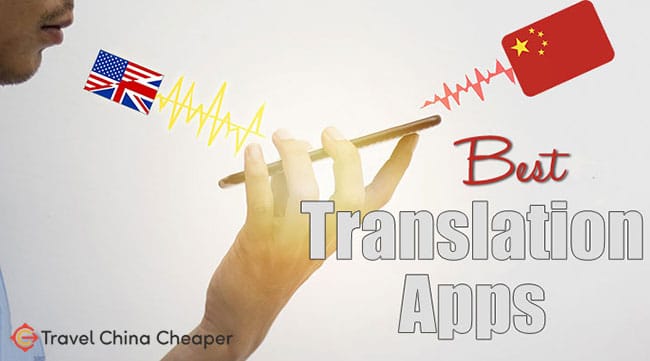
It’s important to note that I’m going to focus on here is specifically voice translation apps.
There are a number of great Chinese dictionary apps or apps that can help you translate Chinese menus or signs using your phone camera.
But that’s not what this is about.
The purpose of these apps is to allow you to speak English (or your native language) into your phone and have it immediately translate and speak the Chinese phrase.
Conversely, a Chinese person could speak to you through your phone and the app will automatically translate English to you.
For tourist and business travelers, these voice translation apps can be a life-saver. As I’ve written before, it is possible to travel China without speaking Chinese, and this use of technology is a primary way to do so.
Important Note
Currently, all of these apps operate using an internet connection for voice translations. Offline mode only works for text-to-text translations. This means that if you want to effectively use a voice translator in China, you’ll need to make sure that you can use your phone on a Chinese network and if not, figure out how to get a Chinese SIM card.
I could inundate you with a list of 10-20 apps. Instead, we’re going to focus on these five popular apps that I’ve had experience using:
Hopefully you’ll find one that works best for you. Enjoy!
Note: Some links in this article are affiliate links, which means that at no extra cost to you, I may be compensated if you choose to use one of the services listed. I only recommend what I’ve personally used, and I appreciate your support!
Baidu Translate | Free & Recommended
The Baidu Translate app (available for iOS devices and Android) is honestly not my favorite voice translator app, but I list it here first for one reason…
…it’s a China-approved app.
What this means is that you won’t have any problems using the app within China. It isn’t blocked by Chinese censorship and it (probably) never will be.
The interface is very simple to understand even though a lot of it is in Chinese. Most people shouldn’t have a problem. Check out some of the screenshot examples below:
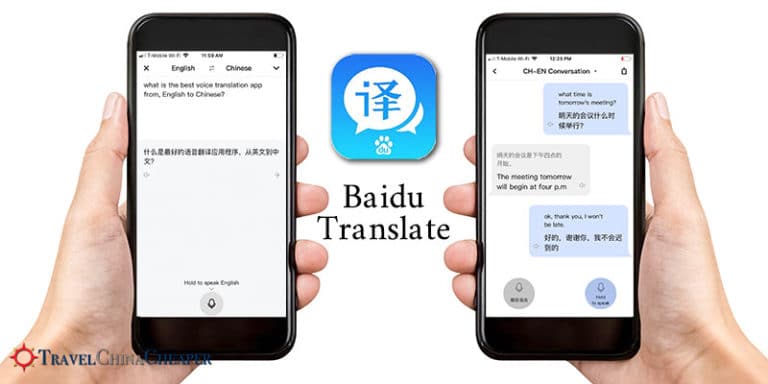
Based on my experience, translations through Baidu Translate are fast and surprisingly accurate. In conversation mode (which you can see on the right above), I like how it uses a text message-style approach to chat history.
There are numerous features (or “mini-apps” as they call it) within the app, but since the app was designed for Chinese people to use, most of them won’t help you.
For example, there’s a Phrase Book mini-app, but it only translates from Chinese to English/Japanese/Korean. There are no English to Chinese phrases.
Baidu Pros
- Guaranteed to work in China
- Free to download and use
- Well-designed conversation mode with chat history
Baidu Cons
- Not designed for English-speaking users
- No offline mode available
- No phrase guides for English
Google Translate | The Best (but blocked)
By far one of the best and most accurate voice translation apps on the market today is Google Translate (available for iOS devices and Android).
There’s only one problem: it’s one of the many Google apps that is blocked in China.
This means that if you want to use Google Translate in China, you’ll need to use a VPN. I personally use ExpressVPN, which allows me to not only access Google Translate but also Instagram, Facebook and many other blocked apps in China.
Google offers voice and conversation translation, as well as the ability to star certain phrases that you want to save for later. Check out the Google Translate screenshots here:
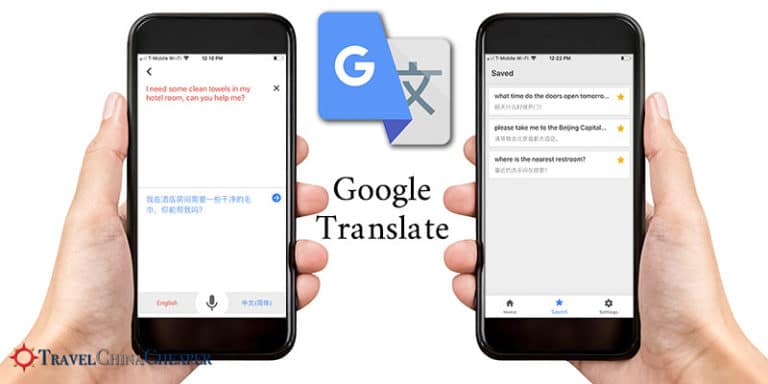
In addition to the voice translation functions, Google Translate offers a great handwriting function (to write in Chinese characters for translation) as well as a camera function.
Unfortunately, in my personal tests the camera function on this and most other apps didn’t work well.
There are a few apps on this list, including Google Translate, that offer an “offline mode” where you download a Chinese language pack. The only downside to this offline mode is that it only works with text, not voice. For voice translations, you’ll still need a network connection.
Google Pros
- Easy-to-Use Save for later feature
- Offline mode for text-to-text translation
- Free download (no paid upgrade)
Google Cons
- Blocked in China (unblock with ExpressVPN)
- Translated conversation voice is very robotic
iTranslate | Beautiful but Pricey
iTranslate is the voice translate app that has the best user experience by far of any others listed here. The only downside is that it’s not free.
As you can see in the screenshots below, the app offers both conversational voice translation as well as a helpful phrase guide with audio pronunciation.
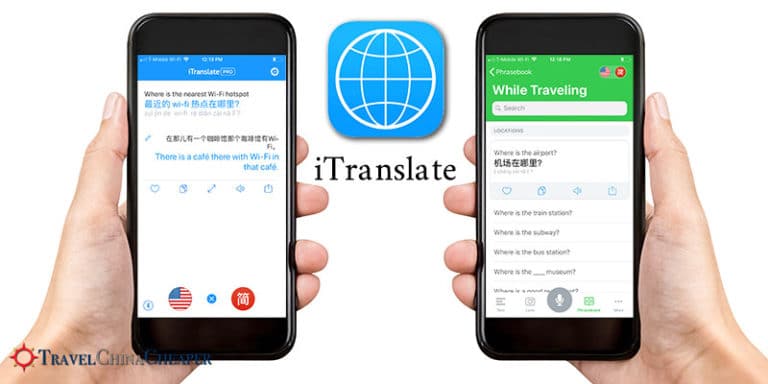
iTranslate functions like many of the other apps on this list, which means that you can type, speak or point your camera at text to get a translation.
For a truly voice-first experience, I recommend you check out the iTranslate Converse app. This app takes the ease of voice translation to a new level.
The idea is that you hold the phone upside-down like a microphone and just press the screen to talk. It automatically detects which language is being spoken and translates.
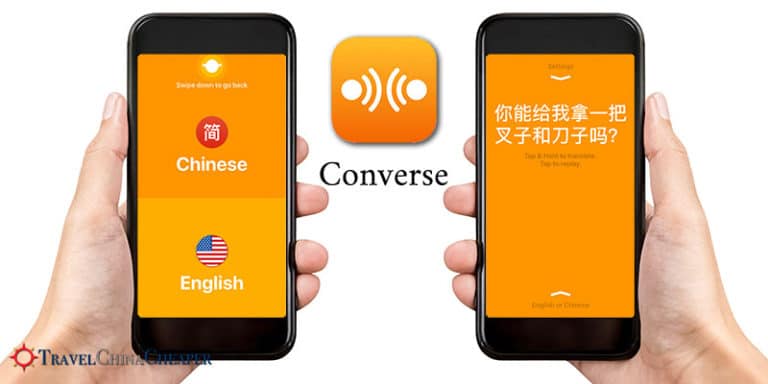
If I were to give an award for design and ease-of-use on this list, Converse would win without question. It’s also one of the only apps that even has an Apple Watch app.
If you don’t consider yourself tech-savvy, you might want to invest in this app as a good voice translation for China.
iTranslate Pros
- Super-fast translation with a pleasant voice
- Offers an Apple Watch app
- 7-day free trial option
iTranslate Cons
- Full version costs money
- Voice translation doesn’t work offline
Microsoft Translator | Free & Unblocked
Although similar to Google Translate, Microsoft Translator has one distinct advantage: it’s (currently) not blocked in China. This is part of what makes it a great voice translator for China.
The app itself is quite simple, but I like how it gives you the option to not only hear the translation but also see it in Chinese characters and pinyin.
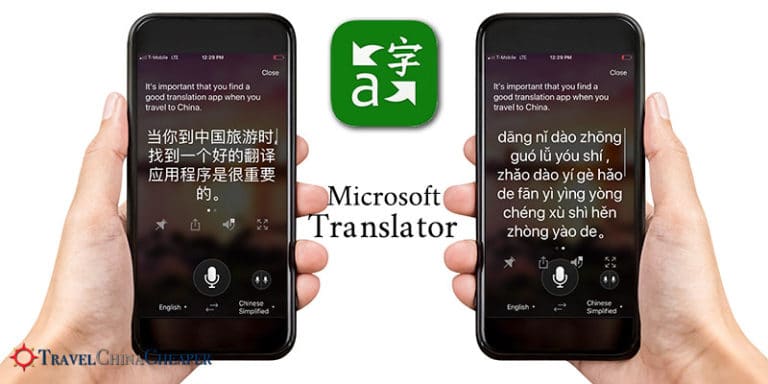
Another feature that makes Microsoft Translator unique is the over-the-network conversation mode.
This means that if multiple phones all have Microsoft Translator, you can connect them with a code and have everybody join the same conversation.
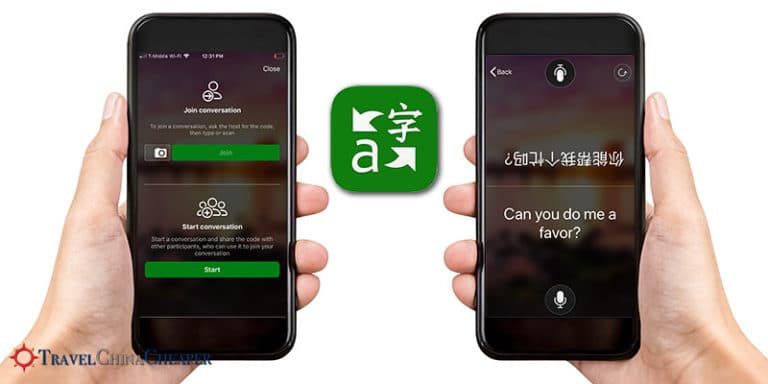
I can see how this might be useful for a multilingual team that needs to communicate easily. You can see the start page for both the over-the-network as well as the in-person conversation views in the screenshots above.
Microsoft Pros
- Simultaneous voice, character and pinyin translation
- In-person and network conversation mode
- Free to use
- Apple Watch app available
Microsoft Cons
- Robotic translator voice
- Offline language file (text to text only) is huge at 98MB
Speak & Translate | Best Design but Pricey
Honestly, I hesitate to mention Speak & Translate, an additional option as a voice translator for China. It’s highly rated in the app store, however it doesn’t do anything better than all the other voice translation apps listed above.
You can see below that the user interface is colorful but a bit clunky.
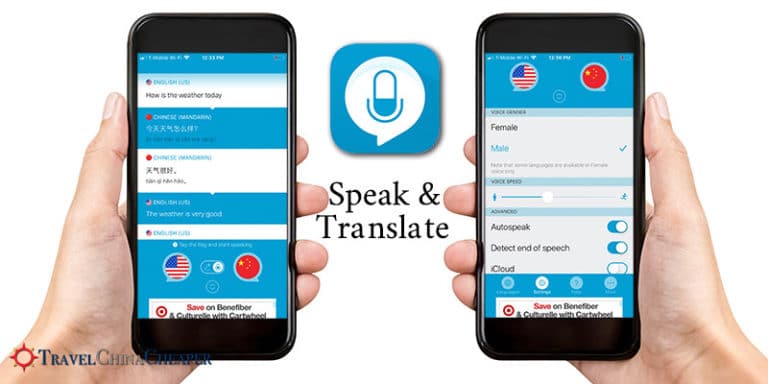
The app is only available for Apple iOS devices (sorry, Android users). It’s a freemium app, which means that you can use it for free (10 translations per day) with tons of ads and annoying popups.
Or you can pay for the full, add-free version.
Speak & Translate Pros
- Excellent conversation scroll to see chat history
- Option for robotic built-in voices (faster) or higher quality voices (slower)
Speak & Translate Cons
- Annoying freemium model
- No Android app available
Final Thoughts | Best Voice Translation Apps for China
In the end, my recommendations boil down to this:
- Are you comfortable downloading a Chinese app? Go with Baidu Translate.
- Do you already have a VPN (such as ExpressVPN)? Go with Google Translate.
- Are you willing to pay for a quality user experience? Go with iTranslate Converse.
- Do you need to have a team translation option? Go with Microsoft Translator.
Most of these apps operate in a similar way, so I don’t think you’ll be disappointed with any app in particular here.
They key is making sure you can use your phone in China on the network to use the voice-to-voice translation features.
Once you have that squared away, these apps make it super easy to make your way around China even if you can’t speak a single word of Chinese!








Hi Josh!
I currently use the App “say hi”, it is free and all my Asian friends (chinese, japanese & korean) tell me that it is very accurate translating.
Look it up, it is available in The Google store.
Thanks for all you do for travelers to china.
JOe
Very interesting, Joe…I hadn’t heard of that app before. I’ll give it a try!
This is so helpful, thank you!
My pleasure, Stephanie! 🙂
We went to beijing, shanghai, hangzhou, zhang jia jie , anji and was able to use offline google translate and show them the chinese text. some of the taxi driver are using baidu translate and we were able to communicate.
we went to local restaurant in slightly remote anji area, they do not have baidu translate so they end up took us to the kitchen and they showed us what they have in their refrigerator and we just selected and they cooked them and we found out the cook are the local champion
Ha! That’s awesome – thanks for sharing. I agree that there are a lot of great offline translators for text. Maybe soon they’ll be able to do offline voice translation.
Nice Article and even I have tried the google translator and its good to use.
Thanks, James. Glad you found good use with Google Translator.
Hi JoSh, thank you fOr this sight very informative. We are visting china soon and wanted to know about the money system. Ive read that we should not accept old wrinkled money. We are from USA and the dollar bills get pretty wrinkled. Can you advise? Also how do we count change?
I’ve lived in China for over 10 years and I never had an issue with wrinkled money. Unless it’s incredibly wrinkled, I wouldn’t work about it.
Hi, In wechat there is a voice translator mini program 面对面翻译 that is very gooD.
I’ve been in china for 8 weeks in connection with work, and the translation app my chinese colleagues there recommended is called “dear translate” – only for android, but it can translate text, talk and pictures (take a photo of a sign and it translates). not 100% accurate, but I guess none of the translators are…
The best app i have used is – Dear translate a chinese app. you can type with an english key pad or wasily swap to a chinese one. you can speak, works so much better than the google app. You can photograph text and it will translate the whole page. plus its free
Thanks Josh. We have a new neighbour who arrived in Australia from Hong Kong just one month ago. He has an app on his phone which has helped us to communicate verbally briefly.
I would like to get an App that will enable me to initiate a conversation in english on my android phone which he can respond to in chinese. What do you suggest?
I think the iTranslate app I mention in this article would do what you’re hoping for.
thank you for the post. i have always wanted to know some basic phase in chinese and this article gave me an idea on were to try from. i downloaded google translator and it is quite good.
Awesome! I’m glad it was useful for you, Joyce!